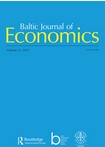Stagflation in Latvia: how long, how far, how deep?
Stagflation in Latvia: how long, how far, how deep?
Author(s): Alf Vanags, Morten HansenSubject(s): National Economy, Energy and Environmental Studies, Economic history, Labor relations, Economic policy, Post-War period (1950 - 1989), Transformation Period (1990 - 2010), EU-Accession / EU-DEvelopment, Financial Markets
Published by: BICEPS/SSE Riga
Keywords: Stagflation; Latvia; Inflation decomposition; EU; Latvian economy; Baltic countries; recession;
Summary/Abstract: This policy paper assesses Latvian inflation performance in an EU and Baltic states context and speculates on the overall prospects for the Latvian economy in the light of the emerging slowdown both in Latvia and elsewhere. On inflation it is likely that, in the absence of new major price shocks, the May 2008 figure represents the peak of the current inflation episode – the slowdown of the economy and thus the unwinding of the overheated labour market should ensure this. On the pace of disinflation, evidence from a simple Phillips curve analysis, together with the flexibility of the Latvian labour market, points in the direction of a fast disinflation, while evidence from other countries emphasises the persistence of inflation. However, the Phillips curve analysis also predicts that lower inflation will come at the cost of higher unemployment. Using two alternative decompositions of inflation the paper examines the balance between a common inflation component and country specific inflation for Latvia and the Baltic states as against the EU-27 and the EU new member states. We find that, irrespective of method used, Latvia has much the biggest domestic inflation component of the three Baltic states. A much more overheated labour market in Latvia and perhaps belated policy response are to blame for the worse performance in Latvia. On duration and depth of a recession in Latvia we use evidence from international experience which suggests that the cumulative loss from a recession might be the equivalent of up to two years of double digit GDP growth relative to trend. Instead of growing 10-11% as was the norm until 2008 Latvia may experience negative growth of perhaps minus 1% for up to two years. This loss of potential GDP is a major setback for the prospects of Latvian convergence.
Journal: Baltic Journal of Economics
- Issue Year: 8/2008
- Issue No: 1
- Page Range: 5-28
- Page Count: 24
- Language: English

